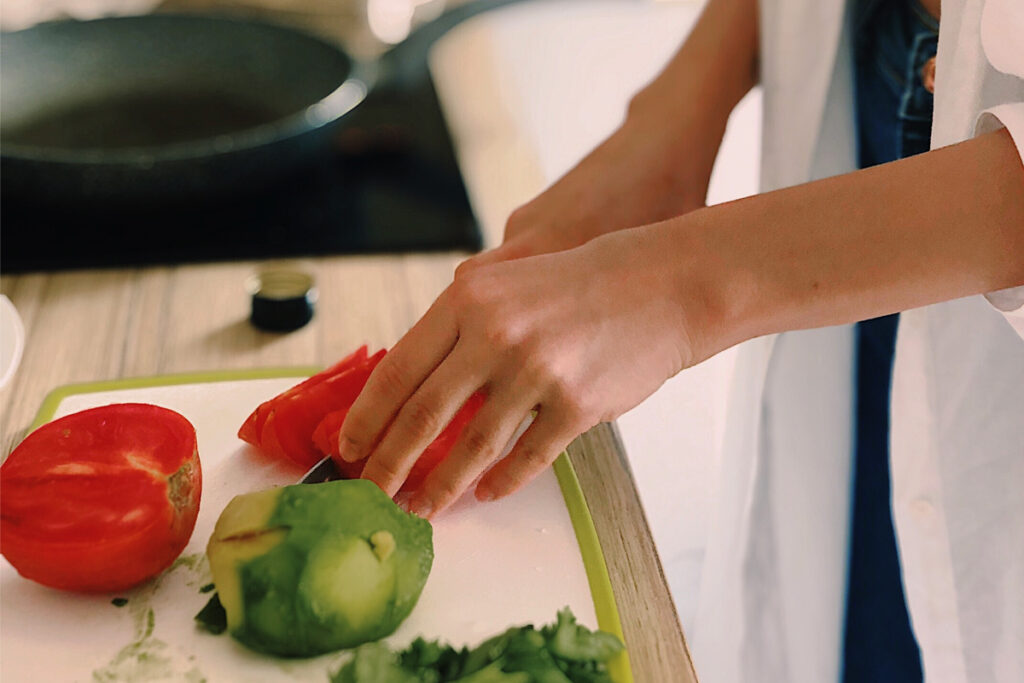Eating for One
by Tara Gidus Collingwood

Eating for One
When you are used to cooking for two or more, adjusting to cooking for one person can be difficult. Not only are there logistics involved, but you may even lose motivation to cook for “just me.” Dinnertime is, for many of us, the most difficult time of the day because it may have been one of the most consistent times that we shared a meal, conversation, and connection with our late husband. It sometimes may feel pointless to us to cook a big meal or sit down at the table all alone. It may feel easier to sit down on the couch with a bag of popcorn and avoid the dinner table.
Even with small children at home when I was first widowed, I often skipped dinner. I just didn’t feel it. I would make the kids something simple and kid-friendly, and I simply didn’t eat or I would munch on cereal. Don’t fall into the trap that you don’t deserve a decent meal for dinner. You DO deserve nourishment. You DO deserve good food that will sustain you and provide you with the energy and health benefits that you need.
Planning
- To ensure what you have is used before expiring, take an inventory of your cabinets and refrigerator before going to the grocery store. Keep the list handy and updated on your phone or refrigerator. It also can serve as a guide when building meals.
- Plan meals around what you already have, aiming to incorporate fruits, vegetables, whole grains, and protein in each meal. Your menu should feature your most perishable foods earlier in the week.
- Work leftovers into the menu by having yesterday’s dinner for lunch or throwing your breakfast scramble into a stir-fry.
- Try to incorporate some of the same ingredients into multiple meals in order to use them before they perish.
- Use a smaller crockpot that can make smaller portions or an Instant Pot.
- Eat leftovers for lunch instead of feeling like you have to eat the same meal for dinner every day.
Shop Smart
To avoid waste, consider purchasing canned and frozen fruits and vegetables instead of fresh. Other ways to keep produce usable longer include freezing bananas and other fruit before they spoil for use in smoothies, sprinkling lemon juice on leftover slices of avocado to prevent browning, keeping certain fruits in the refrigerator to halt the ripening process, or making a big pot of vegetable soup to freeze.
Consider frozen protein like shrimp, burgers, and chicken that is easy to grab a single portion and cook. Utilize frozen sides like risotto, perogies, gnocchi, dumplings, fried rice, etc. Trader Joe’s has an excellent assortment of delicious sides if you have a location close to you. The nice thing about frozen foods such as these is that you don’t even need to cook up the entire package. You can just take half out and cook it and stick the other half back in the freezer.
Organizing/Storing
- When organizing your pantry and refrigerator, keep perishable foods visible. You are more likely to remember what you bought if you can see it, so utilize the first few shelves of your refrigerator to store food that goes bad the quickest.
- Get in the habit of using the first-in, first-out rule by placing newer food behind the older.
- Freeze food that you have too much of that you think might spoil before you have a chance to eat it.
Cook Now and Freeze to Eat Later
Freezing future meals is an easy way to save time and money. Certain foods such as casseroles, lasagna, soups, and stews are perfect for freezing. Make up a big batch to eat for a few days, and freeze the rest for a month or two down the road. Freeze them in individual portions so you can just use them as you desire and don’t need to commit to another week of meals once it is defrosted.
Scale Back Your Recipes
Almost all recipes can be cut back. Start with just simply cutting the recipe in half. If it isn’t possible to scale back, invite a friend over for dinner! Again, you can always freeze the leftovers you won’t eat in the next few days.
Cooking for one person may initially feel challenging, but with a little bit of planning, use of leftovers, and storage planning it can be economical and enjoyable.
Tara Gidus Collingwood, MS, RDN is a Registered Dietitian Nutritionist, Certified Personal Trainer, and fellow Wister. You can find her at dietdiva.net.

